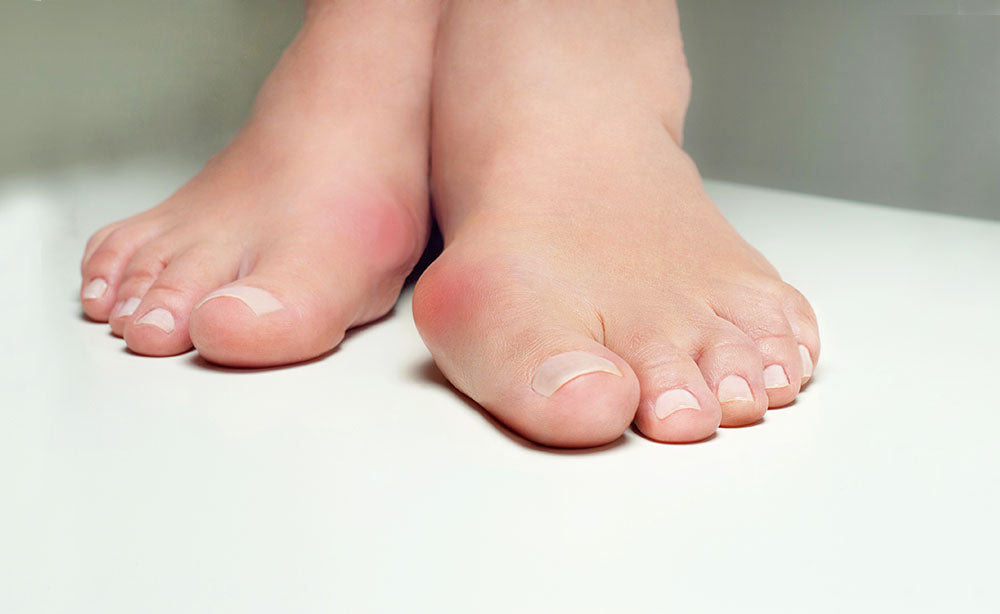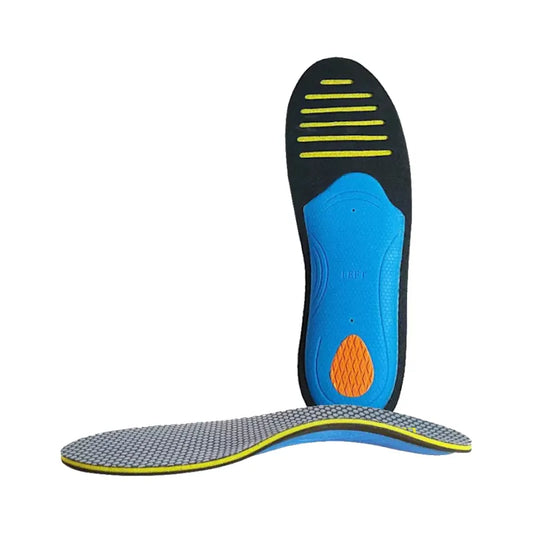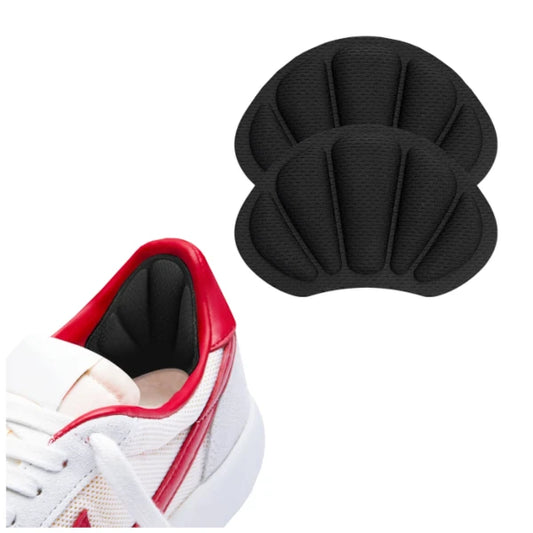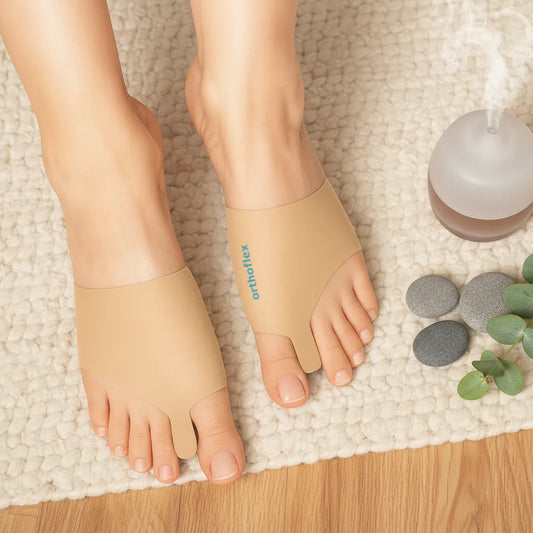
How to shrink bunions naturally? Explore Treatments
Share
Introduction
Bunions, scientifically termed as Hallux Valgus, are a prevalent foot deformity that affects a significant portion of the global population. To truly understand this condition, we must first comprehend the basic structure of the human foot. The foot, a biomechanical marvel, is an intricate structure comprising 26 bones, 33 joints, and over 100 tendons, ligaments, and muscles. This combination allows for a wide range of movements and provides stability, shock absorption, and propulsion. However, such complexity leaves the foot vulnerable to various abnormalities and injuries, one of the most common being bunions.
A bunion is a protrusion that forms at the base of the big toe. This bump is not an overgrowth of bone but rather a manifestation of the shift in the alignment of the metatarsophalangeal (MTP) joint. Under normal circumstances, the MTP joint allows the foot to bend upwards, enabling us to walk and run. However, when the MTP joint shifts out of place, it forces the big toe to lean towards the other toes, creating a distinctive bump at the foot's side, the bunion.

There are some factors that can greatly contribute to the formation of a bunion, such as: Genetics, footwear choices, foot injuries, and pathologies like arthritis. As the condition progresses, individuals may experience discomfort, pain, redness, and even a limited range of motion, making everyday tasks like walking a challenge. In some cases, secondary issues like bursitis, hammertoes, and calluses may arise, further complicating the original situation.
Given the significant impact bunions can have on an individual's quality of life, it's essential to explore the various treatment options available. Broadly, these can be classified into two categories: non-surgical and surgical interventions. The former focuses on symptom management and halting progression, while the latter aims at deformity correction. Each approach has its advantages and disadvantages and may be more suitable for some individuals than others, depending on the severity of the condition, overall health status, and personal lifestyle.
In the following sections of this article, we will dive into these treatments in greater detail, exploring the pros and cons of each one, and discussing their effectiveness. Our goal is to provide you with a comprehensive understanding of the various options available, helping you or your loved ones make informed decisions about bunion treatment but never forget to consult your doctor for a personalized approach, specific to your condition.
Non-Surgical Treatments
Non-surgical treatments are typically the first line of intervention, mainly aimed at relieving symptoms rather than correcting the deformity. The idea is to manage the condition, reduce pain, and prevent further progression.
Footwear Modifications - One of the simplest yet impactful strategies is to modify your footwear. Shoes with a wide toe box, good arch support, and low heels can reduce pressure on the bunion and alleviate discomfort.
Pros: Non-invasive, inexpensive, and able to reduce pain and discomfort immediately.
Cons: It doesn't correct the bunion but only manages the symptoms, and stylish footwear options may be limited.
Bunion Pads and Splints - Over-the-counter bunion pads can protect the bunion from friction with your shoes, whereas bunion splints or braces can help align the toes and reduce the strain on the MTP joint.
Pros: Non-invasive, generally affordable, and can be effective in pain management.
Cons: The corrective effect on the bunion's alignment is generally minimal and temporary, and the products can be uncomfortable or bulky to wear.
Physical Therapy and Orthotics - Exercises to strengthen and stabilize the foot, toe, and lower leg muscles can improve the foot's overall mechanics, while custom orthotics can address structural issues contributing to bunion formation.
Pros: It can help slow the progression of the deformity and relieve discomfort.
Cons: It's a slow process, requires commitment, and might be more expensive due to the cost of custom orthotics and Physical Therapy sessions.
Surgical Treatments
When non-surgical treatments are ineffective, or the bunion impairs significantly pain or mobility issues, surgical intervention may be considered.
Bunionectomy - Also known as bunion removal, involves removing the bunion and realigning the MTP joint.
Pros: The procedure can provide significant relief from pain and discomfort and improve foot function and aesthetics.
Cons: As with any surgery, there's a risk of complications such as infection, nerve damage, and reactions to anesthesia. It also necessitates a recovery period that includes limited mobility and potential for postoperative complications and pain.
Osteotomy - This procedure involves cutting and realigning the bones of the foot and securing them with screws or pins. It's often accompanied by soft tissue correction to improve the foot's alignment.
Pros: Osteotomy effectively corrects the bunion deformity, relieves pain, and restores foot function.
Cons: The recovery period can be prolonged, requiring weeks to months of limited mobility. There's also the risk of bone healing improperly or not at all, and the potential for further health complications.
Arthrodesis - Generally reserved for severe bunion cases or when previous bunion surgery has failed. It involves fusing the bones of the affected joint.
Pros: The procedure provides reliable correction of the deformity and relief from pain.
Cons: It results in a loss of joint mobility and has a longer recovery period compared to other procedures. There are also risks of nonunion (bones failing to fuse) and since it’s the last resort option, has a big role of complications to consider.
Effectiveness of Treatments
It's essential to note that the effectiveness of bunion treatments varies among individuals due to factors such as the severity of the bunion, the individual's overall health, and their compliance with the treatment plan.
Non-surgical treatments generally are effective at managing symptoms but are unlikely to correct the bunion or stop its progression completely, they will help you to manage the condition. Surgical treatments have a high rate of success in terms of pain relief and deformity correction, with studies showing that up to 85% of patients are satisfied with their surgical outcomes. However, recurrence of bunions post-surgery can occur, with estimates ranging from 4% to 25%.
Conclusion
Choosing the right treatment for bunions involves considering many factors including the severity of the bunion, symptom intensity, lifestyle, and patient's overall health. While non-surgical options can manage symptoms and slow progression, surgical interventions provide a more definitive solution but come with their own sets of risks and challenges. It is important for patients to have a detailed discussion with their healthcare provider to select the most appropriate approach for their condition and as soon as you notice a signal of a pressure point on your big toe, start acting as soon as possible.
Author Bio

Marlene Carvalho
Certified Sports Physiotherapist of Elite and Olympic athletes; Performance Coach to racing drivers
Marlene Carvalho is a sports physiotherapist passionate about all things sports.
References
- Nix, S., Smith, M., & Vicenzino, B. (2010). Prevalence of hallux valgus in the general population: a systematic review and meta-analysis. Journal of Foot and Ankle Research, 3(1), 21.
- Ferrari, J., Higgins, J. P., & Prior, T. D. (2004). Interventions for treating hallux valgus (abductovalgus) and bunions. The Cochrane Database of Systematic Reviews, (1), CD000964.
- Menz, H. B., Auhl, M., Tan, J. M., Levinger, P., Roddy, E., & Munteanu, S. E. (2019). Effectiveness of foot orthoses versus rocker-sole footwear for first metatarsophalangeal joint osteoarthritis: randomized trial. Arthritis Care & Research, 71(5), 593-603.
- Dorsey, R., & Hellman, M. (2021). Surgical and nonsurgical management of first metatarsophalangeal joint osteoarthritis. Clinics in Podiatric Medicine and Surgery, 38(3), 447-463.
- Okuda, R., Kinoshita, M., Yasuda, T., Jotoku, T., Kitano, N., & Shima, H. (2009). The shape of the lateral edge of the first metatarsal head as a risk factor for recurrence of hallux valgus. Journal of Bone & Joint Surgery, 91(4), 783-792.
- Nguyen, U. S., Hillstrom, H. J., Li, W., Dufour, A. B., Kiel, D. P., Procter-Gray, E., Gagnon, M. M., & Hannan, M. T. (2010). Factors associated with hallux valgus in a population-based study of older women and men: the MOBILIZE Boston Study. Osteoarthritis and Cartilage, 18(1), 41-46.
- Coughlin, M. J., Saltzman, C. L., Nunley, J. A., & Anderson, R. B. (2012). Angular measurements in the evaluation of hallux valgus deformities: a report of the ad hoc committee of the American Orthopaedic Foot & Ankle Society on angular measurements. Foot & Ankle International, 33(1), 41-56.






